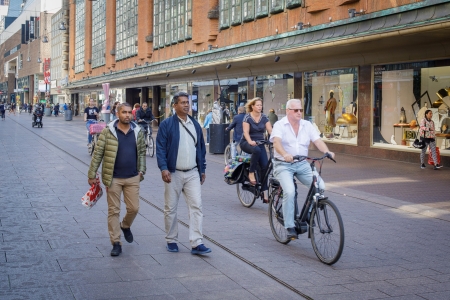Pedestrian crossings
Not all zebra crossings comply with the recommended guidelines [9] [10] [11]. The following recommendations may help improve their safety:
- Speed: ensure that the maximum speed of motorised traffic at the pedestrian crossing is 30 km/h, for example by raising the crossing by means of a plateau.
- Traffic: only use zebra markings at locations where a relatively large number of pedestrians cross the road.
- Crossing length: always implement median islands on distributor roads with two-way traffic, so that pedestrians may cross in two phases.
- Conspicuity: increase conspicuity of crossings by vertical elements, such as speed humps, public lighting and signage.
Objectives in realising safe pedestrian crossings could follow the Swedish example: 'realise a safe speed at x% of all crossings for pedestrians and cyclists, which entails that 85% of all traffic travels at a maximum speed of 30 km/h, or that the crossing is grade-separated [62]. At signalised crossings, road safety may be improved by applying exclusive signal phasing (see the question How to design infrastructural provisions for pedestrians and cyclists to make them as safe as possible? ) and to a more wide-scale switch to the Puffin crossing (Pedestrian User Friendly Intelligent crossing [25]), which has become the standard crossing in the United Kingdom [26] [27]. At such a crossing, pedestrian traffic lights are positioned at the beginning of the crossing and they hold the green light for as long as sensors detect pedestrians on the crossing.
Cyclist crossings
Most crossing crashes with bicycles occur at priority intersections [15]. Crash risk at these intersections may decrease by implementing two-way bicycle tracks less often and speed humps for motorised traffic more often, for example by exit constructions [63] [64].In addition, it is safer when the bicycle track at the intersection is 2 to 5 metres from the carriageway - which is sometimes called ‘deflecting’ the bicycle track – because, for example, cyclists will then not be in the blind spot of a truck taking a right turn [15] [65]. At signalised intersections, measures are possible to keep cyclists out of a truck’s blind spot and to prevent blind-spot crashes. If road sections with bicycle lanes connect to intersections, a bike box where cyclists may position themselves ahead of other traffic may be implemented. Where bicycle lanes connect to intersections, traffic lights could give cyclists a prestart, so that their lights turn green sooner than the lights for other traffic [48].
Bicycle tracks and bicycle lanes
For cyclists, road sections with bicycle tracks are safer than road sections with bicycle lanes, because the risk of a crash with motorised traffic is lower on account of the physical separation [15] [39] [40]. Lack of safety on bicycle lanes may probably be reduced by widening them. Passing motor vehicles will then keep a greater distance to cyclists and cyclists will keep a greater distance to the road shoulder or the kerb[66]. The latter could prevent kerb crashes. Design and maintenance of bicycle tracks could also prevent single-bicycle crashes [17] [64], for example by making them sufficiently wide, removing obstacles, using visual guidance with edge marking and an even road surface and forgiving kerbs and shoulders [14] [15] [16].
